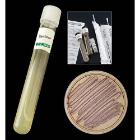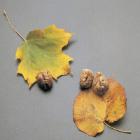You Searched For:
69 results were found
Human+Sensory+Organs+Models
Description:
This organism is commonly isolated from soil, and depending upon the temperature of its environment, can produce a distinctive red pigment.
Description:
This organism is a common inhabitant of intestinal flora, and can be a major cause of urinary tract infection.
Description:
This organism is occasionally isolated from soil, but most frequently from smegma- a secretion from male and female genitalia.
Catalog Number:
(470180-128)
Description:
Termite flagellates live in the intestine of Zootermopsis termites as symbiotic organisms. They can be easily isolated and observed.
Description:
Kocuria rhizophila is also commonly known by the name Micrococcus luteus. This organism is commonly isolated from soil, and is frequently used to tes...
Description:
From sewage and human intestine. Causes dysentery.
Description:
Frequent human isolate. Causes gastroenteritis.
Catalog Number:
(470179-168)
Description:
Isolated from the alimentary tract of cows. Lancefield group D, gamma hemolysis. May be pathogenic in humans.
Description:
Isolated from human nasopharynx, saliva, and sputum. Spontaneously agglutinates in saline.
Description:
Isolated from sewage, human intestines, and urinary tract infections. Spreading colonies are seen on agar growth medium.
Catalog Number:
(470179-166)
Description:
Lancefield group C, beta hemolysis. Causes strangles in horses. May be pathogenic in humans. Camp test negative; resistant to bacitracin, does not fer...
Catalog Number:
(470179-178)
Description:
Isolated from human saliva, sputum, and intestine. No Lancefield group shown, alpha hemolysis.
Catalog Number:
(470179-154)
Description:
isolated from human intestine. Lactose positive and sucrose positive after a few days’ growth. Causes a mild form of dysentery.
Description:
Ames test strain for detecting carcinogens. Causes infection in humans.
Catalog Number:
(470179-132)
Description:
Isolated from human nasopharynx. Presumably not related to N. sicca; some relation to N. gonorrhoeae. Often agglutinates in saline.
Catalog Number:
(470176-400)
Description:
A fascinating predator to study; as it lies in wait for its prey, its posture makes it appear to be praying, giving the insect its common name.
Inquire for Price
Stock for this item is limited, but may be available in a warehouse close to you. Please make sure that you are logged in to the site so that available stock can be displayed. If the
Stock for this item is limited, but may be available in a warehouse close to you. Please make sure that you are logged in to the site so that available stock can be displayed. If the
This product is marked as restricted and can only be purchased by approved Shipping Accounts. To apply for a shipping account number, click here. If you need further assistance, call Customer Service at 800-962-2660 or email [email protected].
-Additional Documentation May be needed to purchase this item. A VWR representative will contact you if needed.
This product has been blocked by your organization. Please contact your purchasing department for more information.
The original product is no longer available. The replacement shown is available.
Limited quantities of this product are available. To check availability or place an order, call Customer Service at 800-962-2660 or email [email protected].
|
|||||||||














